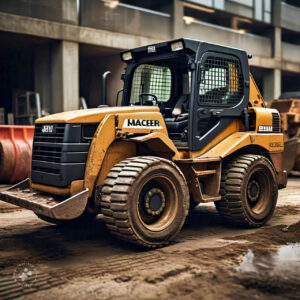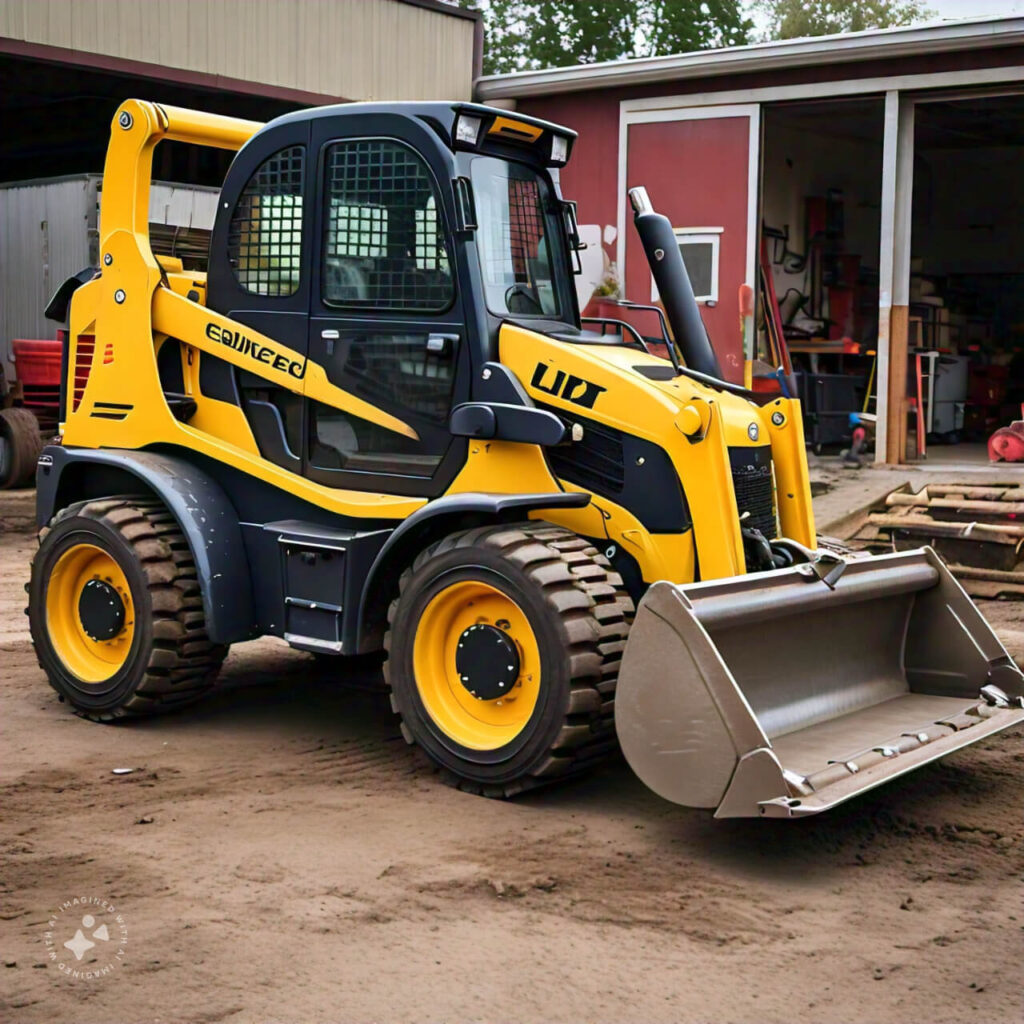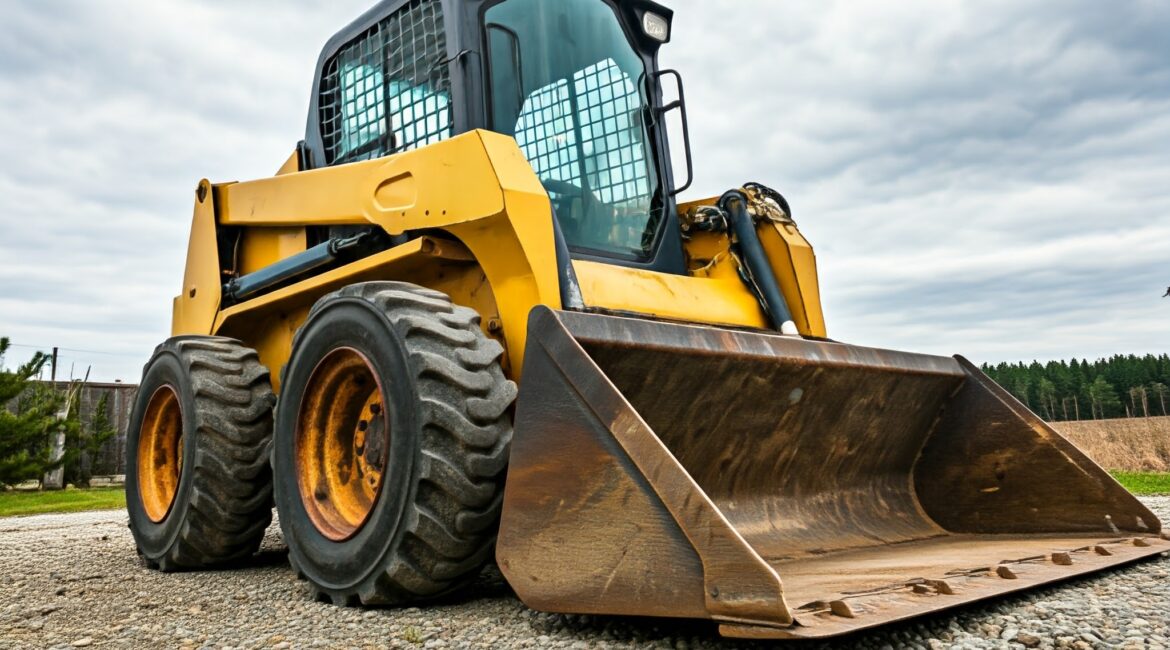When you need new tires for your skid steer, choose not only the set with the lowest cost. Over time, not selecting the proper skid steer tires for your needs might wind up costing more money.
You work hard on the jobsite with your skid steer; select tires that will last a long time and perform just as hard.
Importance of Skid Steer on the Jobsite
On a construction site, skid steers have several purposes depending on the attachments you install to the front. The only factors limiting the jobs a skid steer can complete are the strength of the machine and the count of attachments. Your skid steer loader can have certain typical attachments with purposes like:
- Grapple: Take a grab and carry action. Cleaning and demolition call for a skid steer grapple bucket.
- Dozer Blades: Choice of attachment for clearing, grading, leveling, cutting, pushing, stacking.
- Stump Buckets: Made for excavating and pulling up stumps, skid steer stump buckets
- Broom: Using a broom simplifies job site cleaning
- Auger: On a jobsite, an auger attachment on a skid steer lessens your work on a drilling hole project.
- Landscaping Tiller: Forget separate tillers for plowing big garden areas; this adapter will transform your skid steer into a digger.
- Utility Fork: A utility fork performs better than a bucket for facility lifting and movement of hay and other such materials.
- Dirt Bucket: Specifically made for lifting and carrying dirt from a job site are dirt buckets.
- Pallet Fork: A pallet fork adapter makes your skid steer suitable for lifting and securely moving pallets if you need to move a few but do not want to rent a forklift.
These attachments only show a small range of the choices accessible from several manufacturers for skid steers. Your manufacturer’s construction equipment accessories will provide many more.Your choice of tires will affect the performance of your skid steer loader on the task, just as your choice of attachment will affect that. Correct tires help to minimize downtime and increase output. On a skid steer loader, if you choose the incorrect tires for your requirements, you might be losing both time and money.
While multi-terrain loaders utilize belts to drive in snow and other harsh environments, skid steers normally run on wheels. You may purchase an over-the-tire track that will transform your skid steer loader into a multi-terrain vehicle to enjoy the best of both worlds.
Industry-Specific Needs
Your business probably controls your skid steer loader’s usage. Although many building and demolition operations use these machines, their modest size allows nearly anywhere usage.
You will have to consider the surroundings you utilize the skid steer in as well as the accessories you employ when choosing your tires. Although the performance of the vehicle might depend on the degree of grip the tires have on the ground, too much grip can damage a landscape. Knowing how to choose the correct tire for your skid steer becomes in part about juggling the two.
These are some lists of sectors and the tires they might require.
- Mining: Durable tires with a larger footprint can let you drive across rock-strewn quarries and extend lifetime and wear. In the difficult circumstances of the mining business, an off-road layout is very essential. Although their smoother ride on rocky roads helps pneumatic tires fit this scenario, they are nevertheless prone to flats from jagged objects on the ground. Use this tire kind carefully in mining operations.
- Construction: The state of the building site will define the kind of tires utilized. Non-marking tires can help virtually finished locations with smooth pavement avoid harm to the region. On smooth concrete, on the other hand, you could need more traction and thus deeper treads. Flat-proof tires shield your car against construction trash-induced damage.
- Demolition:Like skid steers used in building need strong, flat-proof tires, so too do vehicles employed in demolition. The trash on the ground requires tires not prone to puncturing over sharp things. Wider tires with all-terrain treads can help you to improve ground traction, particularly while transporting big items. These architectural elements will provide a mix between driver comfort and long-life.
- Extreme Use Tasks: You require tires that will perform to such extremes if you will drive the skid steer loader to its pushing or pulling restrictions. Install tires with rims bonded inside to prevent tire and rim separation from the too strong force applied to the car and its wheels. With such a bonded construction, you will not have to worry about the tires locking in place during use and the rims spinning.
- Recycling: Driving a skid steer around a recycling plant requires flat-proof solid cushion tires when there is broken metal, glass and other debris in the vicinity. Solid cushion tires can help you avoid regular flats that could cause operations to be stopped.
- Standard Use: Generally speaking, normal pneumatic tires with dirt tread would be sufficient for driving across dirt. These tires, however, run the danger of possibly flattening during use.
Solid Cushion or Solid Skid Steer Tires vs. Pneumatic Skid Steer Tires

When selecting tires, your first concern should be whether you want pneumatic or solid cushion tires. Both kinds have unique qualities; you might choose one or the other, particularly if you run your skid steer as an owner-operator.
1. Solid Cushion Tires or Solid Skid Steer Tires
The fact that solid skid steer tires never have to stop operating to fix a flat appeals most of all. Pneumatic tires run great danger of puncturing objects like rebar, jagged rocks, or building trash in highly demanding uses like demolition sites or rock quarries. The best in puncture resistance comes from solid skid steer tires, which reduces worker and machine downtime and repair expenses.
Though solid skid steer tires are more expensive up front, they last 3 to 5 times as long, and in severe situations, up to 10 times longer than pneumatic skid steer tires, which means fewer tires will be needed. The equipment will continue running for significantly longer between tire replacements without downtime from flat tires, hence your return on investment (ROI) also rises. Less downtime and increased uptime are features of solid skid steer tires.

2. Pneumatic Tires
Because of their cushioning action, pneumatic tires often provide higher driver comfort. On occasion, nevertheless, these tires call for air pressure checks and refills. Furthermore, if you drive your skid steer across trash-filled building sites including nails and other sharp items, your car may develop a flat that would cause it to be out of operation for the remainder of the day.
Different Tread Design Options
Your sector and the location of your skid steer will guide you in selecting an appropriate tread design for your project. Shallow designs are excellent on roads or when you wish to have the least effect on the surroundings. Though you will need deeper treads, which provide more grip, if you must drive over mud, sand, dirt, gravel or any loose stuff.
Your options include:
- Off-Road Treads: Off-road treads, meant for usage in every circumstance, deliver your skid steer loaders where you need them regardless of the presence of mud, snow, sand or gravel. Use these tires off-road, preferably, as they might wear out early on.
- On-road treads: You require on-road treads for asphalt and concrete driving. Though they are not used off-road, they offer the smoothest ride available. Using on-road tires in difficult areas might cause you insufficient grip.
- All-Terrain Treads: Deeper grooves and more rubber abound in the treads meant for all-terrain use Whether driven over loose materials like snow, gravel or sand or over firm asphalt roads, these changes enable this kind of tire to grab the ground.
Tread Compound Options
Manufacturers differ greatly in the chemicals they employ to make tires. The materials also rely on your type of cushion tires—solid or pneumatic. Solid cushion tires include three layers of different rubber compounds, each with a designated use. The middle layer softens the ride; the top layer offers a barrier against debris damage; the innermost binds the tire to the rim without ripping.
For pneumatic tires, the use determines the composition. Standard rubber makes up regular duty tires; heavy duty ones include extra-strong rubber that reduces wear. Stronger rubber, more rubber and deeper depth make the most durable pneumatic tires perfect for demanding situations. These three qualities guarantee that these tires will soften the ride while also allowing them to withstand harsh handling and use on difficult terrain. Still, frequent air checks are necessary for even the heaviest pneumatic tires to guarantee correct performance.
Why Selecting the Right Tire Helps ROI
Your decision of tires determines your return on investment. Knowing which skid steer tires would be suitable for your project site will help you to save downtime and extend the lifetime of the tires.
Compared to pneumatic tires used on rough terrain, tires made for use on concrete are usually tougher and more durable. On snow, nevertheless, you might not acquire the grip required if you drive on concrete tires with shallow tread. Though their name suggests otherwise, using a skid steer loader should not cause sliding. Using the incorrect tires in tough circumstances could lead to slippage, mishaps or injury.
The amount of time the tires will endure depends on how you utilize them. Some instances of lifetime, depending on skid steer tire use, span 400 to 1400 hours:
- Demolition Contractors: Driving on the uneven ground of a debris-covered demolition site can limit the 400 hours of usage for skid steer tires.
- General Contractors: From a set of tires, a general contractor who usually runs a skid steer loader on flat, level terrain like asphalt parking lots, concrete roadways or dirt roads may obtain up to 800 hours of use.
- Owner Operators: Skid steer tires allow conscientious owner-operators who carefully choose and operate the suitable tires to squeeze up to 1400 hours of use.
Choose tires with the best depth of tread for the longest lifespan. The tread depth of skid steer loaders is exactly related to tire lifetime. For example, those with 20 percent deeper tread should last 20 percent longer than ordinary tires.
Choosing tires that do not support your skid steer and operation can cause them to wear out far faster than those made for your car. See your tire maker to be sure a pair of tires will fit your skid steer. Replacement tire manufacturers know a great deal about the equipment they produce tires for and which of their goods performs best for particular uses.
Increase Your ROI on Tires
Selecting the correct tires for skid steer loaders in your fleet can help you to raise your ROI. Keeping those tires and cars helps you to guarantee maximum return on investment. Closing your business to replace a tire is the last thing you want. Maintaining tires and lowering unexpected failures can help to reduce profit loss, as up to 20 percent of the running cost of your skid steer comes from tires.
Check for Wear
Following every use, check the tires. Sort trash and look at the tires for wear-related marks such as holes, missing tread, fractures, and a shallow tread. Signs of wear point to a tire replacement needed before it fails. If you have pneumatic tires, you may also search for tires devoid of air pressure, implying a probable leak. Furthermore, keep in mind that larger, huge machines want repairs sooner than smaller skid steers and strain harder on the tires.
Protect Tires From Damage
There are various ways you might extend the lifetime of your skid steer tires and lighten their load. Remove your counterweight if your skid steer employs one when not absolutely necessary. This reduces the weight applied to your tires.
Use tire fittings for your application as well. On streets, never use off-road tires to avoid wear. Stronger tires are needed for heavy-duty uses than for light-duty chores. If you use your skid steer in a range of environments, think about all-terrain tires or pick one that fits the surface you most often.

